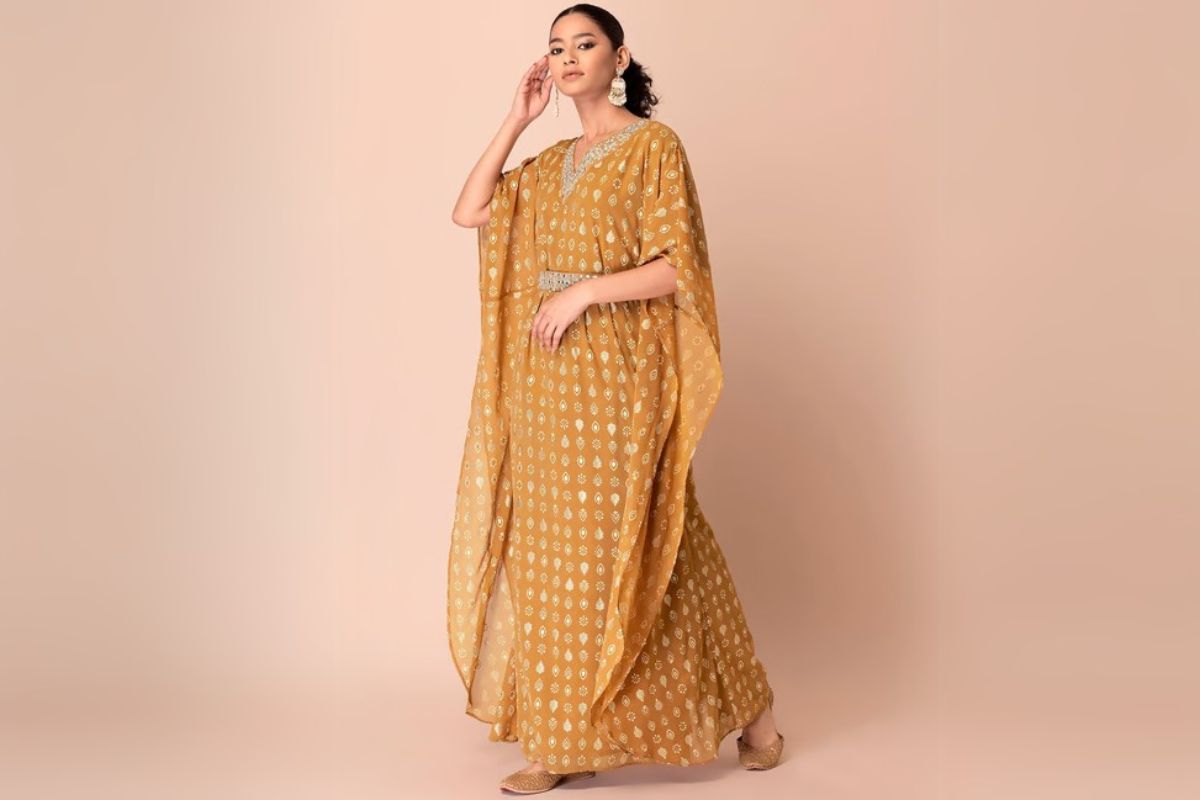People from all over the world have worn the kaftan for hundreds of years. It is a standard piece of clothing. The first people to wear this style of clothes did so in the Middle East, Central Asia, and North Africa. It’s become a fashion icon that people all over the world love since then. Lots of different people have worn it in many different ways over the years because of its flowy, open shape. The kaftan has a long past. This page talks about that history, what it means in different cultures, and how it is worn today. It also explains why people like it and how it fits into fashion today.
Table of Contents
A Look Back at History
Its roots can be found in the civilizations of Mesopotamia, Persia, and the Ottoman Empire. The word “Kaftan” comes from Latin. People in the Middle East, North Africa, and some parts of Europe love this dress. Over hundreds of years, each culture added its special touch to the pattern, fabric, and decorations.
The kaftan also became a royal symbol in the Ottoman Empire. The kings and sultans wore intricately embroidered kaftans made of luxurious materials such as silk and velvet, often in gold and silver threads. Such an expensive appearance and complex designs conveyed richness and power. The Ottoman kaftans had long sleeves and flowed down to the floor, enhanced with elaborate motifs and embellishments, making them a high-status symbol of the elite.


The kaftan was common among both genders in Iran, though it was commonly associated with royalty and nobles. The Persian kaftans were made from thick fabrics, such as velvets and silk brocades, which were rich with precious stones and heavy with extensive embroidery. This garment spread during the 1600s and 1700s to some regions of Europe by trade lines and diplomatic visits.
The Kaftan in Different Cultures
Although the kaftan originated in the Middle East and Persia, it has been adopted by many cultures and regions around the world, each putting its own unique stamp on it.
Middle Eastern and North African Kaftans
In many countries in the Middle East and North Africa, people wear kaftans every day and for important events. The traditional “caftan” is something that women in Morocco wear to weddings and public events. A lot of the time, satin or silk is used to make Moroccan caftans. They look like works of art because they have so much detailed stitching, beads, and other things on them. A lot of people love the jewel tones, gold, silver, and other bright colors of the Moroccan caftan.
The kaftan has the same traditional meaning in Tunisia and Algeria. It is worn on holidays, celebrations, and other special events. Usually, jewelry, scarves, and belts are worn with them to make it look better.
The Kaftan in Asia and Central Asia
In Central Asia, the kaftan is known by different names. For example, in Kazakhstan and Uzbekistan, it is called the “chapan”. Designs differ, but generally, these are open-fronted garments, usually worn over other clothing. Here, the kaftan is worn as an outer garment and traditionally carries very colorful patterns and embroidery, reflecting the cultural and historical influences of this region. The fabrics used include silk, wool, and cotton, and designs can be highly intricate.
Significant in Turkish history, the kaftan is still worn today by many people who style it both traditionally and modern. People who wear Turkish kaftans often get their arms and necks chopped and sewed in a way that is distinctive for them. For special occasions and festivities, especially in rural areas, the kaftan is still widely worn as part of traditional clothing.
Kaftans in the Western World
Originally, a kaftan was an Oriental garment; its charm crossed to the West and became quite famous in the 20th century. Kaftans are often seen to have been quite the fashion of Europe and America, especially among stars and other great fashion designers during the 1960s and 1970s. Elizabeth Taylor and Jacqueline Kennedy, for instance, were among those who did not miss to sport kaftans, symbolizing glamour and the bohemian lifestyle.
During the counterculture movement, the kaftan stood for freedom and relaxation. It was a sign of comfort, ease, and breaking away from strict fashion rules. Yves Saint Laurent and Halston, among others, used the kaftan in their collections, showing it as a stylish and modern choice for evening wear or just sitting around.
As is the case, today, a kaftan has made it back into vogue again in Western fashions among high-end and cheap fashion brands incorporating the garment as part of the seasonal collections. It is almost always seen around summer festivals and in resorts during beach vacations as well as island getaways that are styled like a comfortable, yet sophisticatedly dressed outfit.
Modern-Day Interpretations and Fashion Trends
Of course, the kaftan has evolved to reflect the interests of the current generation, but its essential design remains comfortable and elegant. Today, kaftans come in every style, texture, and colour, from beachwear to the most elegant evening dresses. Contemporary designers frequently experiment with new ways to cut, fabric, and embellish kaftans, resulting in modern trends such as uneven hemlines, sheer fabrics, and minimalist designs.
Probably one of the biggest modern applications of the kaftan is resort wear and vacation wardrobes. The light fabrics of cotton, chiffon, and linen are common materials used in the design of a kaftan, which can be used comfortably in hot climates. It can be dressed in sandals or wedges and makes for a perfect cover-up to swimwear or an outfit for dinner by the beach.
Kaftans have been worn in a lot of different ways on the runway. Diane von Furstenberg and Roberto Cavalli are two designers who have used kaftans in their collections and paired them with jewelry and other pieces that make a statement.
The Sustainable Fashion Movement
The loose, fluid design of a kaftan and the fabric used, for example, the cotton and the silk, position it as suitable for the trend of sustainable clothing. Many designers consider using eco-friendly materials and ethical manufacturing for modern kaftans that seem stylish and sustainable. Going forward, such a garment or a style could be in an increased demand mainly because of changing consumer awareness.
Conclusion
The kaftan is a garment that has withstood centuries of cultural influences and become a global fashion staple. Despite its origins in the Middle East and Central Asia, the kaftan continues to be a symbol of style, comfort, and adaptability. The kaftan continues to captivate and inspire people all around the world, whether worn as traditional clothing or as a fashion statement. This demonstrates that this iconic piece of apparel will not be going away anytime soon.




